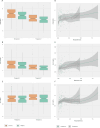Longitudinal changes in cardiovascular disease-related proteins in welders
- PMID: 38958674
- PMCID: PMC11416389
- DOI: 10.1007/s00420-024-02086-8
Longitudinal changes in cardiovascular disease-related proteins in welders
Abstract
Objective: Occupational exposure to welding fumes is linked to a higher risk of cardiovascular disease; however, the threshold exposure level is unknown. Here, we aimed to identify changes in proteins associated with cardiovascular disease in relation to exposure to welding fumes.
Methods: Data were obtained from two timepoints six years apart for 338 non-smoking men (171 welders, 167 controls); of these, 174 (78 welders, 96 controls) had measurements available at both timepoints. Exposure was measured as personal respirable dust (adjusted for personal protective equipment), welding years, and cumulative exposure. Proximity extension assays were used to measure a panel of 92 proteins involved in cardiovascular processes in serum samples. Linear mixed models were used for longitudinal analysis. The biological functions and diseases related to the identified proteins were explored using the Ingenuity Pathway Analysis software.
Results: At both timepoints, the median respirable dust exposure was 0.7 mg/m3 for the welders. Seven proteins were differentially abundant between the welders and controls and increased incrementally with respirable dust: FGF23, CEACAM8, CD40L, PGF, CXCL1, CD84, and HO1. CD84 was significant after adjusting for multiple comparisons. These proteins have been linked to disorders of blood pressure, damage related to clogged blood vessels, and chronic inflammatory disorders.
Conclusion: Exposure to mild steel welding fumes below current occupational exposure limits for respirable particles and welding fumes in Europe and the US (1-5 mg/m3) was associated with changes in the abundance of proteins related to cardiovascular disease. Further research should evaluate the utility of these proteins as prospective biomarkers of occupational cardiovascular disease.
Keywords: CVD; Occupational exposure limit; Respirable dust; Welding.
© 2024. The Author(s).
Conflict of interest statement
The authors declare no competing interests.
Figures

References
-
- Aggarwal A, Schneider DJ, Terrien EF, Sobel BE, Dauerman HL (2004) Increased coronary arterial release of interleukin-1 receptor antagonist and soluble CD40 ligand indicative of inflammation associated with culprit coronary plaques. Am J Cardiol 93:6–9. 10.1016/j.amjcard.2003.09.003 - PubMed
-
- Altemose B, Robson MG, Kipen HM, Ohman Strickland P, Meng Q, Gong J, Huang W, Wang G, Rich DQ, Zhu T, Zhang J (2017) Association of air pollution sources and aldehydes with biomarkers of blood coagulation, pulmonary inflammation, and systemic oxidative stress. J Expo Sci Environ Epidemiol 27:244–250. 10.1038/jes.2016.38 - PubMed
-
- Antonini JM, Lewis AB, Roberts JR, Whaley DA (2003) Pulmonary effects of welding fumes: Review of worker and experimental animal studies. Am J Ind Med 43:350–360. 10.1002/AJIM.10194 - PubMed
-
- Antonini JM, Afshari AA, Stone S, Chen B, Schwegler-Berry D, Fletcher WG, Goldsmith WT, Vandestouwe KH, Mckinney W, Castranova V, Frazer DG (2006) Design, construction, and animals. J Occup Environ Hyg 3:194–203. 10.1080/15459620600584352 - PubMed
MeSH terms
Substances
Grants and funding
LinkOut - more resources
Full Text Sources
Medical
Research Materials
Miscellaneous

